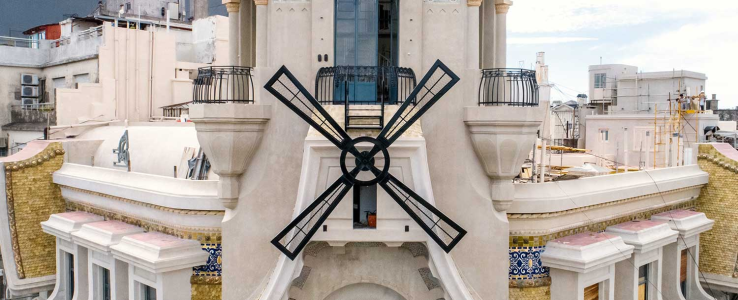Confiteria Del Molino
The Confitería del Molino has been witness to the last hundred years of the City.

Where?
1815 Rivadavia Avenue, Congress neighborhood
Google Maps
Find local businesses, view maps and get driving directions in Google Maps.
When?
Guided tours: Tuesday and Thursday, 10 a.m. and 2 p.m. Last Saturday of each month, 10 a.m. and 1 p.m.
Tickets
👉https://delmolino.gob.ar/
Free access
The Confitería del Molino has been witness to the last hundred years of the City. After two and a half decades of being closed, and after extensive remodeling work, although it is still not open for you to go and have a coffee, it offers the “ Molino Experience, a guided tour .” These are visits that allow you to learn about the restored spaces and the history of this emblematic building, told by a team of specialists. They are free but with limited spaces and require prior individual registration through the website delmolino.gob.ar .
A lot of history
Its beginnings date back to the mid-19th century, when pastry chefs Constantino Rossi and Cayetano Brenna opened the “Confitería del Centro”, on Rodríguez Peña and Av. Rivadavia. In 1866, they changed the name to "Antigua Confitería del Molino", as a tribute to the first steam flour mill in the City. But it was only in 1905 when Rossi and Brenna bought the premises on the corner of Av. Rivadavia and Av. Callao, right in front of the National Congress.The project meant a big bet, which included bringing furniture from Italy, buying top-of-the-line glassware, having marble details, stained glass, handles and bronze finishes. Finally, the imposing Confitería del Molino was inaugurated on July 9, 1916, in commemoration of the Centennial of Independence and soon became an emblem of art nouveau in Argentina.
Great challenges
In 1930, the establishment experienced one of its toughest moments because, during the coup d'état that overthrew Hipólito Yrigoyen, it suffered a fire and closed its doors. The reconstruction took almost a year.In 1978, a business bankruptcy occurred and the confectionery was purchased by the grandchildren of Cayetano Brenna, who introduced a series of improvements to adapt it to the new times.
It survived, until a new economic crisis, in 1997, caused it to end up melting down. That same year it was declared a National Historical Monument but that did not prevent it from remaining closed for a quarter of a century.
The Renaissance
In 2014, the building was transferred to the National Congress and the Administrative Commission of the Mill Building began a series of recovery tasks for this architectural icon. In a joint work between the City of Buenos Aires, Congress and the national Government, a multidisciplinary team of specialists worked to value the material and intangible heritage of the place and return it to its splendor.Social life scene
In addition to a large number of political figures, famous artists, such as Niní Marshall and Libertad Lamarque, circulated through this space. Also, authors of the stature of Oliverio Girondo and Roberto Arlt, who even wrote about this traditional place in Buenos Aires. Carlos Gardel left his mark on Leguisamo, a dessert that he asked the pastry chef Brenna to honor his friend, the jockey Irineo Leguisamo. Shortly before the last closure, the singer Madonna, who was in the country filming the movie “Evita”, chose the Confitería del Molino to record a video clip.Did you know…?
- In the year of the Bolshevik revolution, Brenna invented the "Russian imperial", a dessert that became known to the world as "the Argentine dessert."
- The tango “Gricel", by José María Contursi and Mariano Mores, reflects a unique love story between Contursi and the protagonist of the song, who met again at the Confitería del Molino 22 years after their breakup.
- It was known as the "Third Chamber" because it was the meeting space par excellence between senators and national deputies.
- Lisandro de la Torre drank coffee here every day. Alfredo Palacios also enjoyed his cognac and the coffee ritual every day. Furthermore, he had the habit of leaving his overcoat in the living room, so as not to be so sheltered in Congress, and he would pick it up on the way out.

